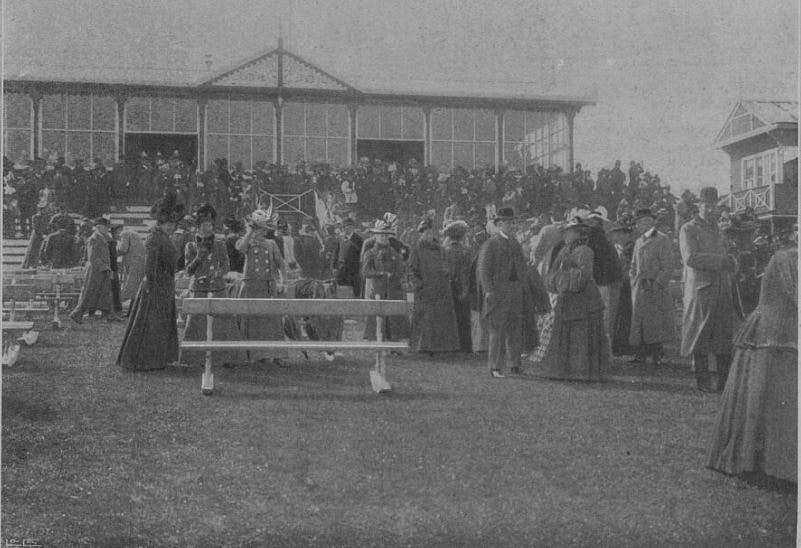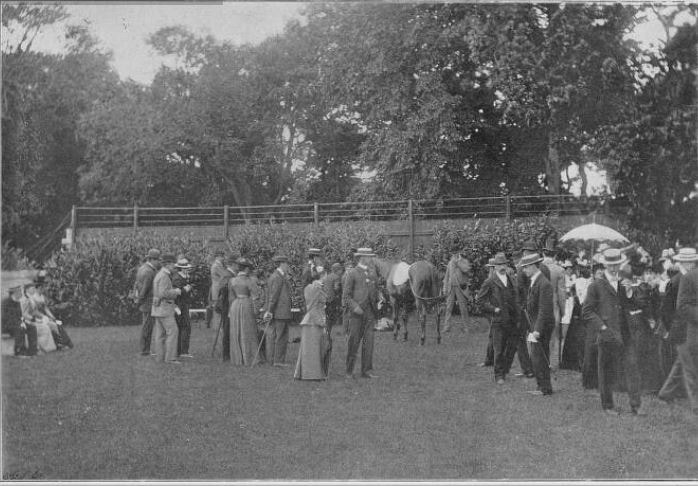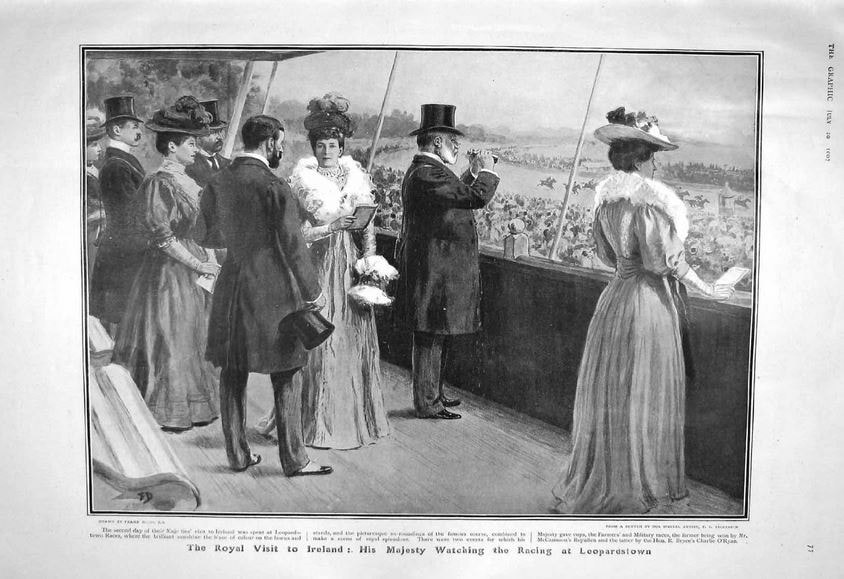Leopardstown House
Leopardstown farm/Leopardstown House/Leopardstown Racecourse
Leopardstown as Gaeilge is ‘Baile na Lobhar’, meaning 'town of the lepers' according to John O'Donovan of the Griffiths Valuation team and also historically called Ballinlore. It is believed that the name derived from the owners of the lands in Medieval times who had a Lazar (Leper) House, subsequently called The Leper Hospital of St Stephens based at Stephen’s Street, later Mercer's Hospital where the Royal College of Surgeons of Ireland’s heritage centre is now. According to the Dublin Corporation records for the year 1230, Geoffrey Tyrel and his wife Sara surrendered their land of Ballygyregan between Kilmacud and Tipperstown to St Stephen’s Hospital. The rents from these lands supported St Stephen’s Hospital. There is little evidence of a hospital in the area but given that lepers were to have separate churches and there was one at Leperstown in the Deanery of Taney noted in the church census of 1533, perhaps it was the site of a leper hospital. The name morphed over the centuries and by the 18th century the area was known as Leopardstown.
John Hawkins of Leopardstown, published a prospectus for the establishment of an agricultural college at Leopardstown in 1844. He applied for the patronage of the Royal Agricultural Society of Ireland (RGSI) but was refused. The farm consisted of about 200 acres at Leopardstown and the fee was £15 per student pa. The college was open by Feb 1845 and the students had manual labour for part of the day with an experienced agriculturist, and the other part was spent with a literary master learning geometry, arithmetic, geography, book-keeping etc. One of their first projects was to drain the land. This was done by digging trenches 32” deep, 18 feet apart and filling them with small stones. By May 1845, 47 students were enrolled and Dr Thomas Antisell gave lectures on Agricultural Chemistry. By October 1845 John and his son Anthony John had the patronage of the RDS and the RASI. Edmund Murphy was a landscape gardener and improver of estates. He was also ex editor of the Farmer Gazette and author of the Irish Farmer’s Almanac and he was in charge of Leopardstown Agricultural College. He was later editor of The Agricultural and Industrial Journal and Author of a " Treatise on Agricultural Grasses, and of The Farmer's Guide.” He resigned after the death of John Hawkins in 1846 aged 69. Edward Carroll was Head agriculturalist and retired in 1850, his retirement was considered a serious loss to the college by Sir Robert Kane. No further mention of the College has been found after 1850. Anthony took over the running of the model farm after the death of his father. He took up residence in a house near the farmyard and retained the better portion of the lands in his own possession. He called his new residence Leopardstown House (to differentiate it from Leopardstown Park House). Anthony John became ill and the model farm was run by Anthony Nolan, his steward who remained with him 17 years. A J moved to England, where he died in 1866 aged 59. He left 25K in personal estate and the lands were put up for sale in 1867.
It appears that Father John Sullivan of the Benedictine Fathers purchased the land in February 1867 for 17K though the Encumbered Estates Court. Father John Sullivan was raising turkeys on the farm two years later. He was the superior of the Benedictine establishment of lay brothers at Leopardstown or Prefect of the Anglo-Hibernian Province of the Benedictino Order, and ran the model farm. Open days included ploughing competitions and they employed a lot of local labour. They paid men 1s 8d per day and boys 10d and it was calculated to cost between 30s and 42s per acre to clear each acre of stones and weeds. In 1874 The Order opened an agricultural college for ten students. In 1877 they were 6k in debt, the steam engines and steam ploughs were put up for sale with a note that the men now out of employment were familiar with every aspect of farming, used to working on the steam machinery and were looking to be engaged, these included four brothers by the name of Hollander. The college was closed and various portions of the land were put up for lease on a yearly basis but the order retained the old farm house. In 1880 some Cassinese Benedictine Monks, who had been expelled from the Monastery of Pierre qui Vire in France, arrived via St Augustine’s Monastery in Ramsgate to the Leopardstown Benedictines, they would remain for two years. In 1882 the Benedictine order purchased Buckfast Abbey and the French exiles left for England where they started production of what would become a very famous brew.
In 1888 it was announced that 180 Irish acres at Leopardstown recently in the possession of Father Sullivan had been purchased by a company for racing purposes. In total 230 statute acres of land were purchased by Quin and a number of other gentleman for the sum of 8K from the Land Judges Court in London. Capital of £20000 was raised by £10 shares. A club was formed, along the lines of the club at Sandown, managed by Captain George Quin ex The Curragh Racecourse and also a stake holder. The run of the course would be left to right like that of the English Derby and the Paris Steeplechase the opposite of races run in Ireland. Captain Quin was keeper of the Match Book in Ireland and remained as secretary and general manager of the Leopardstown Club until his death at Leopardstown House on 19 Jul 1917. The course was completely surrounded by a high stone wall and they hoped to have coursing, polo meetings and lawn tennis courts were to be constructed. Initially there would be a public standhouse (accommodating 600), a members standhouse (accommodating 1200), buffets, retiring rooms and offices. There was even an ambulance room and press room. The track was to be 1 ¾ miles long. A straight and level 5 furlong course was also planned but was not ready until October 1888. The grass was to be maintained in summer by a Vartry water supply. The rings and enclosures were asphalted and a new design of telegraph boards was installed. The cost of the building was 16K and included a vice regal stand painted in cream and blue as the Lord Lieutenant (Earl of Aberdeen) had accepted an invitation to the first days racing. Construction was by Messrs H & J Martin of Dublin & Belfast. 4.5K pieces of glass and crockery were commissioned for use in the buffets and dining area. These were in various colours to match the colour of the stands each etched or painted with 'Leopardstown Club'. Entrance was through the Foxrock train station and the railway company offered a special fare including admission to the racecourse and ran special non stop trains from Harcourt street on race days. Not all the local residents were keen, some complained that their property would be devalued by up to 25% and given that this was only three miles from Kingstown where 'the worst of the roughnecks in the county lived' the area would be subjected to scenes of mayhem on race days.
They were granted a six day liquor licence for four bars on the property in October 1888 which could used on race days or on any fete days (excluding Sunday). Racegoers complained about a lack of food on the opening day so Tom Corless of the Burlington was contracted to arrange future catering.
A committee was formed to oversee membership and admission of members was by ballot. The admission committee members included; Lord Annaly, the Earl of Clonmel, the Earl of Fingal and Percy La Touche. Officers on full pay and gentlemen belonging to some of the private clubs in Dublin like the Kildare Street Club could become members without ballot. Annual subscription was 5 guineas for admission for one gentleman and two ladies, or 3 guineas for a single gentleman. 110 tons of Portland cement was poured and the inauguration meeting was held on the 27 Aug 1888 (the day before the Dublin Horse Show opened) and the Clerk of the Course was Mr E F Hewison ex Curragh and righthand man to Captain Quin. Nannie Power O'Donohue, journalist with the Illustrated Sporting and Dramatic News gives a blow by blow account of the mayhem than ensued on opening day. E F retired in 1907 and died in 1908.
The race course was acquired by the Horse Racing Board of Ireland in 1967.
© June Bow & Karen D'Alton - February 2023.
Return to Leopardstown Racecourse
Leopardstown as Gaeilge is ‘Baile na Lobhar’, meaning 'town of the lepers' according to John O'Donovan of the Griffiths Valuation team and also historically called Ballinlore. It is believed that the name derived from the owners of the lands in Medieval times who had a Lazar (Leper) House, subsequently called The Leper Hospital of St Stephens based at Stephen’s Street, later Mercer's Hospital where the Royal College of Surgeons of Ireland’s heritage centre is now. According to the Dublin Corporation records for the year 1230, Geoffrey Tyrel and his wife Sara surrendered their land of Ballygyregan between Kilmacud and Tipperstown to St Stephen’s Hospital. The rents from these lands supported St Stephen’s Hospital. There is little evidence of a hospital in the area but given that lepers were to have separate churches and there was one at Leperstown in the Deanery of Taney noted in the church census of 1533, perhaps it was the site of a leper hospital. The name morphed over the centuries and by the 18th century the area was known as Leopardstown.
John Hawkins of Leopardstown, published a prospectus for the establishment of an agricultural college at Leopardstown in 1844. He applied for the patronage of the Royal Agricultural Society of Ireland (RGSI) but was refused. The farm consisted of about 200 acres at Leopardstown and the fee was £15 per student pa. The college was open by Feb 1845 and the students had manual labour for part of the day with an experienced agriculturist, and the other part was spent with a literary master learning geometry, arithmetic, geography, book-keeping etc. One of their first projects was to drain the land. This was done by digging trenches 32” deep, 18 feet apart and filling them with small stones. By May 1845, 47 students were enrolled and Dr Thomas Antisell gave lectures on Agricultural Chemistry. By October 1845 John and his son Anthony John had the patronage of the RDS and the RASI. Edmund Murphy was a landscape gardener and improver of estates. He was also ex editor of the Farmer Gazette and author of the Irish Farmer’s Almanac and he was in charge of Leopardstown Agricultural College. He was later editor of The Agricultural and Industrial Journal and Author of a " Treatise on Agricultural Grasses, and of The Farmer's Guide.” He resigned after the death of John Hawkins in 1846 aged 69. Edward Carroll was Head agriculturalist and retired in 1850, his retirement was considered a serious loss to the college by Sir Robert Kane. No further mention of the College has been found after 1850. Anthony took over the running of the model farm after the death of his father. He took up residence in a house near the farmyard and retained the better portion of the lands in his own possession. He called his new residence Leopardstown House (to differentiate it from Leopardstown Park House). Anthony John became ill and the model farm was run by Anthony Nolan, his steward who remained with him 17 years. A J moved to England, where he died in 1866 aged 59. He left 25K in personal estate and the lands were put up for sale in 1867.
It appears that Father John Sullivan of the Benedictine Fathers purchased the land in February 1867 for 17K though the Encumbered Estates Court. Father John Sullivan was raising turkeys on the farm two years later. He was the superior of the Benedictine establishment of lay brothers at Leopardstown or Prefect of the Anglo-Hibernian Province of the Benedictino Order, and ran the model farm. Open days included ploughing competitions and they employed a lot of local labour. They paid men 1s 8d per day and boys 10d and it was calculated to cost between 30s and 42s per acre to clear each acre of stones and weeds. In 1874 The Order opened an agricultural college for ten students. In 1877 they were 6k in debt, the steam engines and steam ploughs were put up for sale with a note that the men now out of employment were familiar with every aspect of farming, used to working on the steam machinery and were looking to be engaged, these included four brothers by the name of Hollander. The college was closed and various portions of the land were put up for lease on a yearly basis but the order retained the old farm house. In 1880 some Cassinese Benedictine Monks, who had been expelled from the Monastery of Pierre qui Vire in France, arrived via St Augustine’s Monastery in Ramsgate to the Leopardstown Benedictines, they would remain for two years. In 1882 the Benedictine order purchased Buckfast Abbey and the French exiles left for England where they started production of what would become a very famous brew.
In 1888 it was announced that 180 Irish acres at Leopardstown recently in the possession of Father Sullivan had been purchased by a company for racing purposes. In total 230 statute acres of land were purchased by Quin and a number of other gentleman for the sum of 8K from the Land Judges Court in London. Capital of £20000 was raised by £10 shares. A club was formed, along the lines of the club at Sandown, managed by Captain George Quin ex The Curragh Racecourse and also a stake holder. The run of the course would be left to right like that of the English Derby and the Paris Steeplechase the opposite of races run in Ireland. Captain Quin was keeper of the Match Book in Ireland and remained as secretary and general manager of the Leopardstown Club until his death at Leopardstown House on 19 Jul 1917. The course was completely surrounded by a high stone wall and they hoped to have coursing, polo meetings and lawn tennis courts were to be constructed. Initially there would be a public standhouse (accommodating 600), a members standhouse (accommodating 1200), buffets, retiring rooms and offices. There was even an ambulance room and press room. The track was to be 1 ¾ miles long. A straight and level 5 furlong course was also planned but was not ready until October 1888. The grass was to be maintained in summer by a Vartry water supply. The rings and enclosures were asphalted and a new design of telegraph boards was installed. The cost of the building was 16K and included a vice regal stand painted in cream and blue as the Lord Lieutenant (Earl of Aberdeen) had accepted an invitation to the first days racing. Construction was by Messrs H & J Martin of Dublin & Belfast. 4.5K pieces of glass and crockery were commissioned for use in the buffets and dining area. These were in various colours to match the colour of the stands each etched or painted with 'Leopardstown Club'. Entrance was through the Foxrock train station and the railway company offered a special fare including admission to the racecourse and ran special non stop trains from Harcourt street on race days. Not all the local residents were keen, some complained that their property would be devalued by up to 25% and given that this was only three miles from Kingstown where 'the worst of the roughnecks in the county lived' the area would be subjected to scenes of mayhem on race days.
They were granted a six day liquor licence for four bars on the property in October 1888 which could used on race days or on any fete days (excluding Sunday). Racegoers complained about a lack of food on the opening day so Tom Corless of the Burlington was contracted to arrange future catering.
A committee was formed to oversee membership and admission of members was by ballot. The admission committee members included; Lord Annaly, the Earl of Clonmel, the Earl of Fingal and Percy La Touche. Officers on full pay and gentlemen belonging to some of the private clubs in Dublin like the Kildare Street Club could become members without ballot. Annual subscription was 5 guineas for admission for one gentleman and two ladies, or 3 guineas for a single gentleman. 110 tons of Portland cement was poured and the inauguration meeting was held on the 27 Aug 1888 (the day before the Dublin Horse Show opened) and the Clerk of the Course was Mr E F Hewison ex Curragh and righthand man to Captain Quin. Nannie Power O'Donohue, journalist with the Illustrated Sporting and Dramatic News gives a blow by blow account of the mayhem than ensued on opening day. E F retired in 1907 and died in 1908.
The race course was acquired by the Horse Racing Board of Ireland in 1967.
© June Bow & Karen D'Alton - February 2023.
Return to Leopardstown Racecourse


